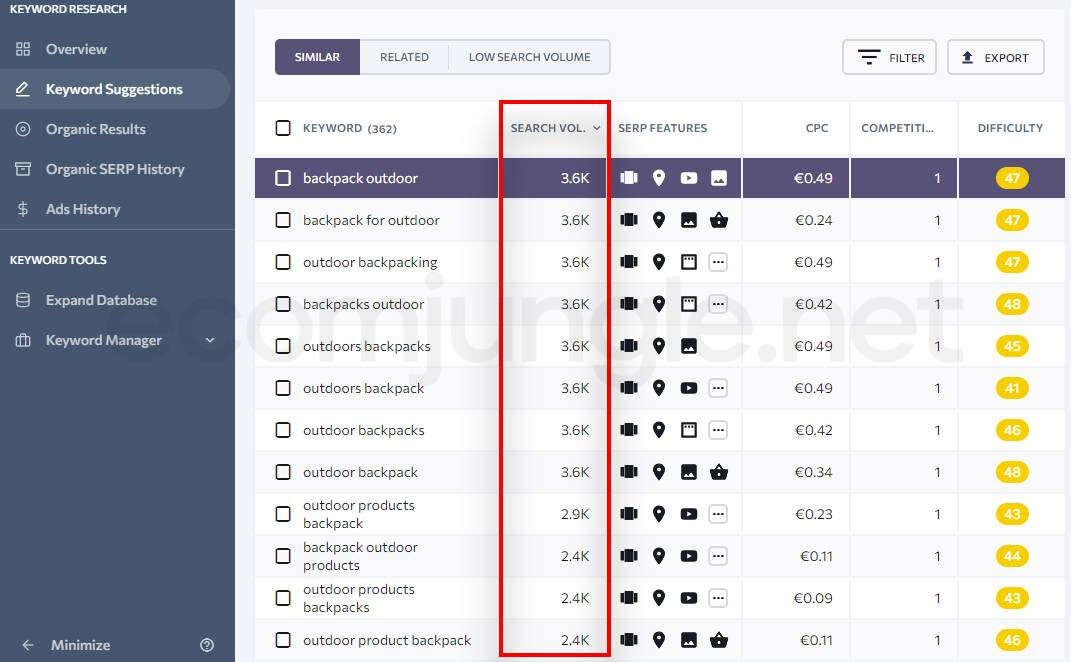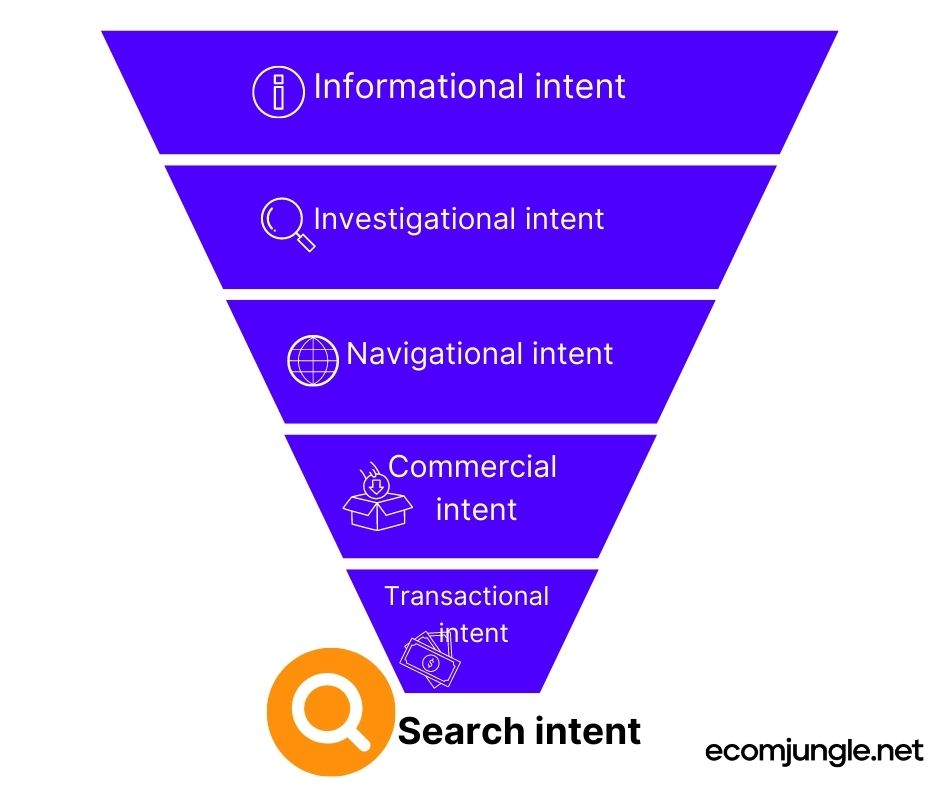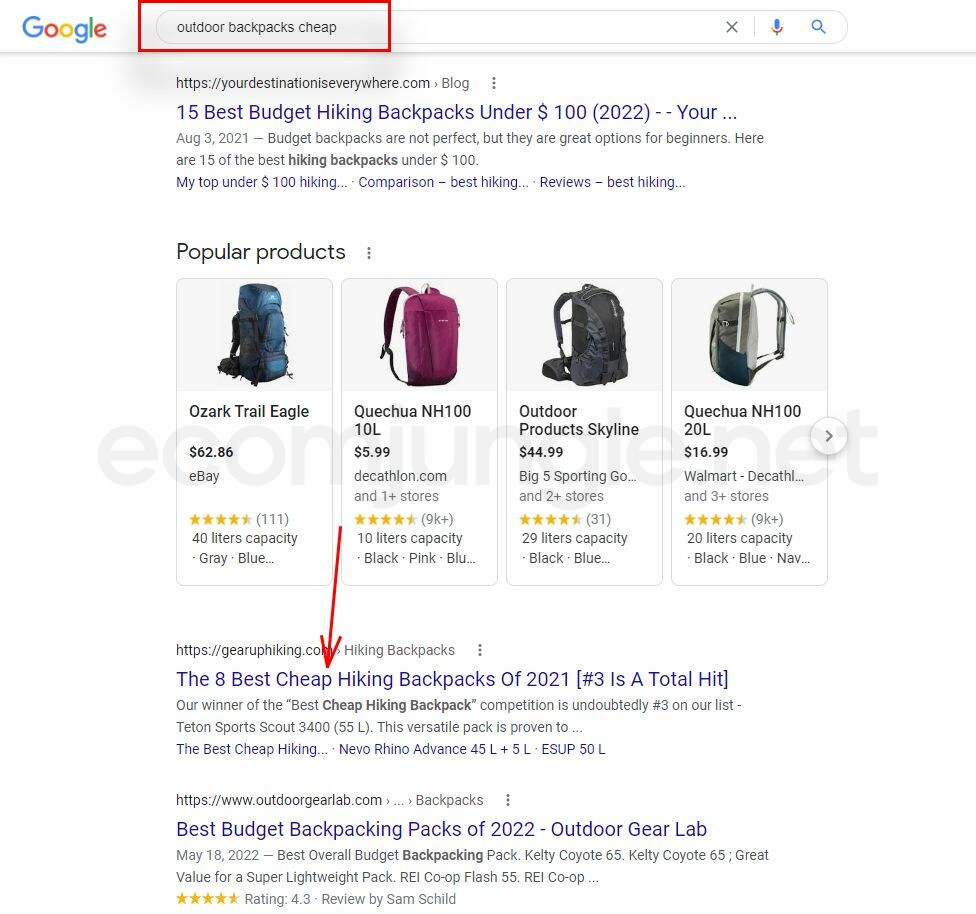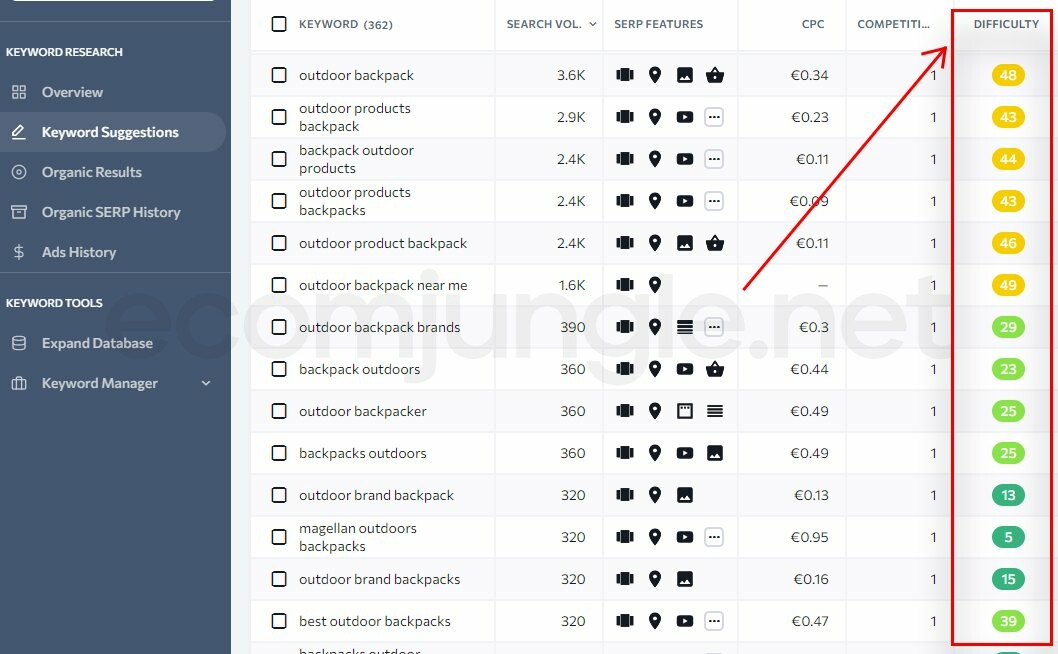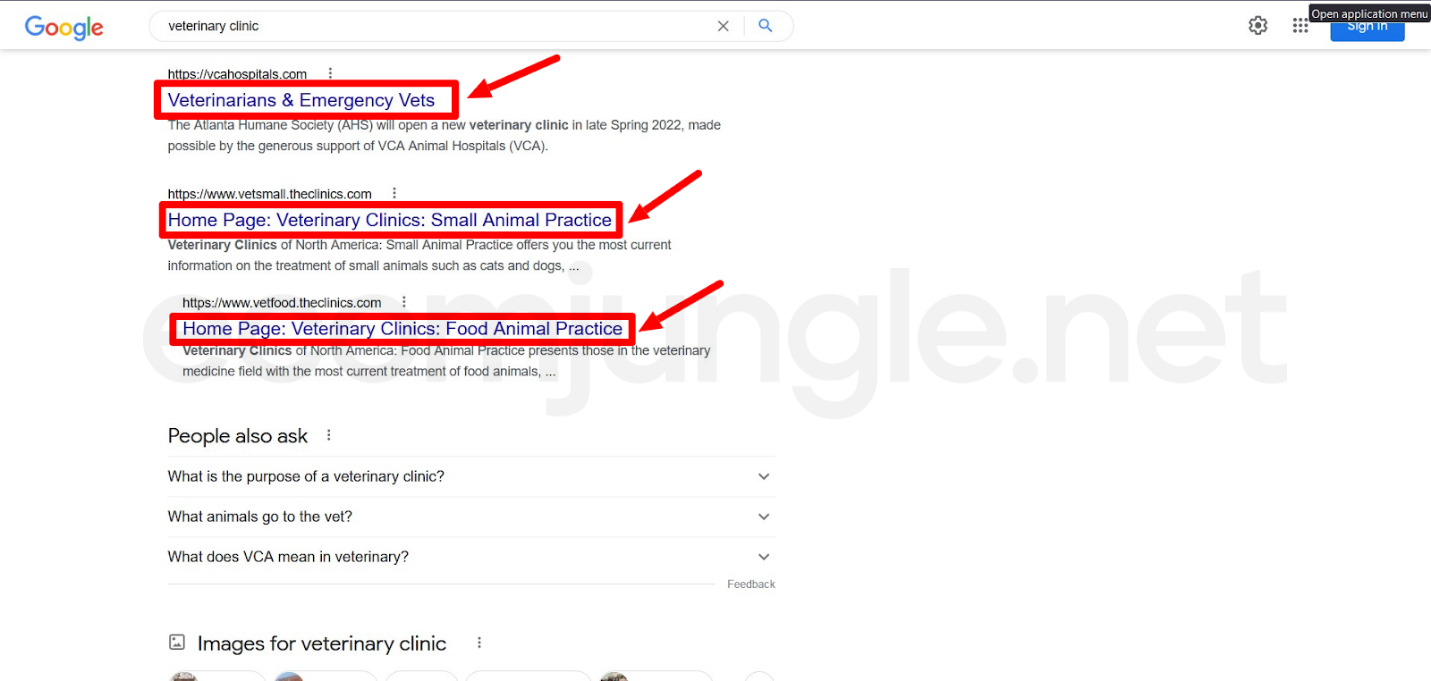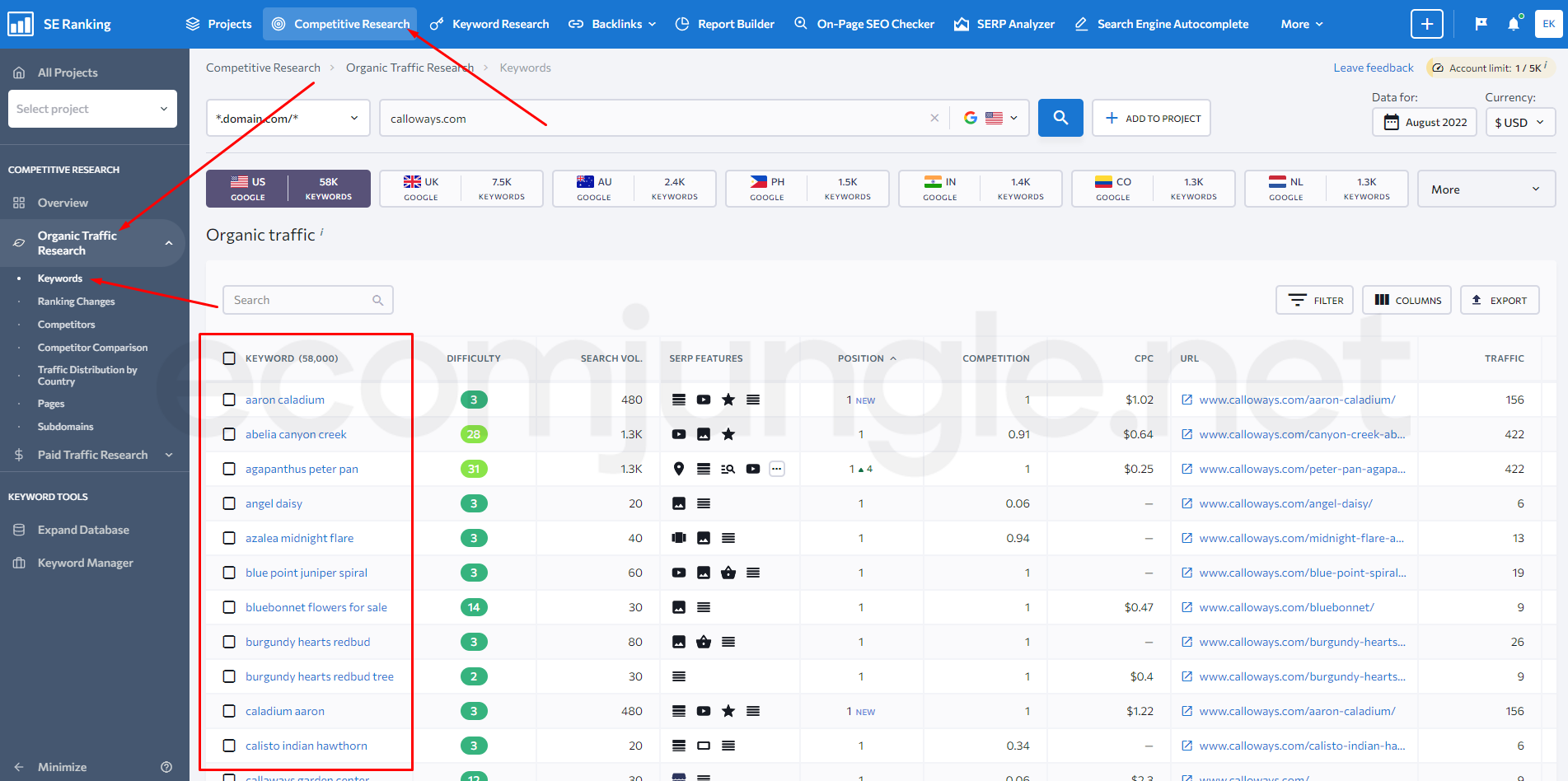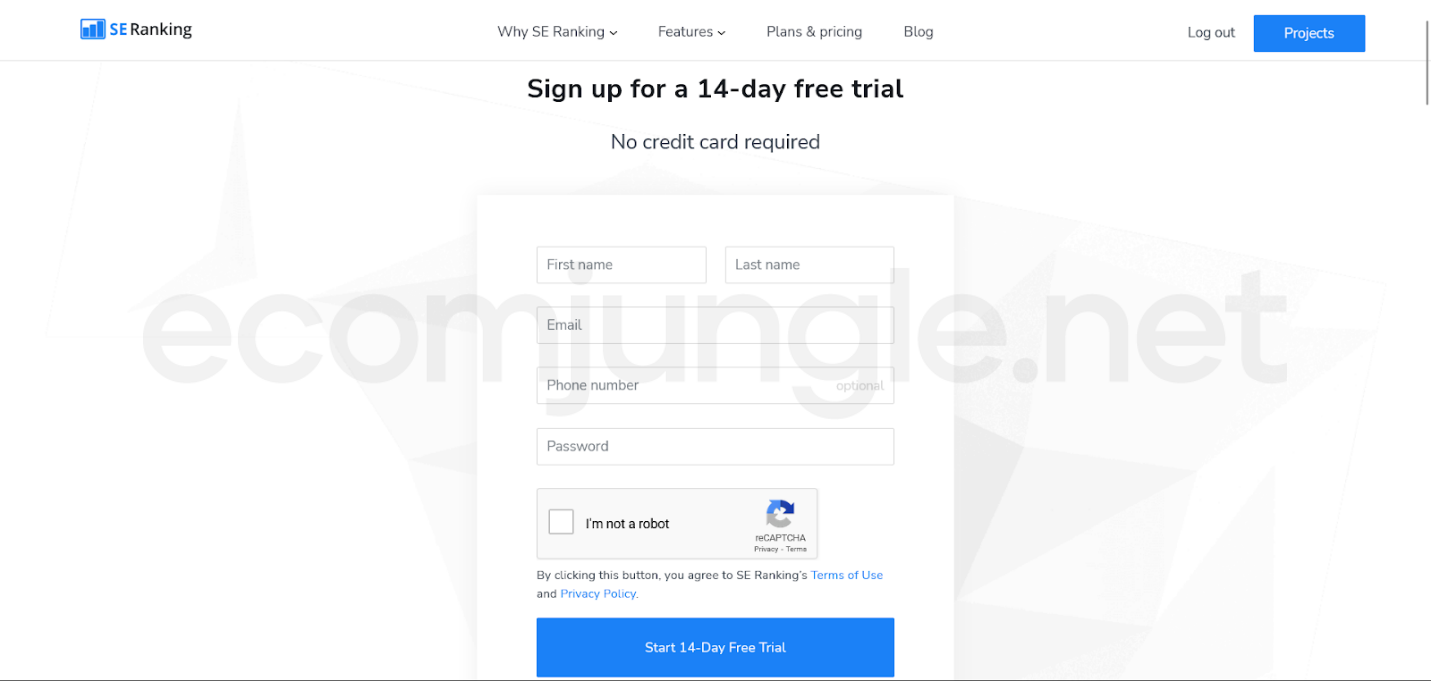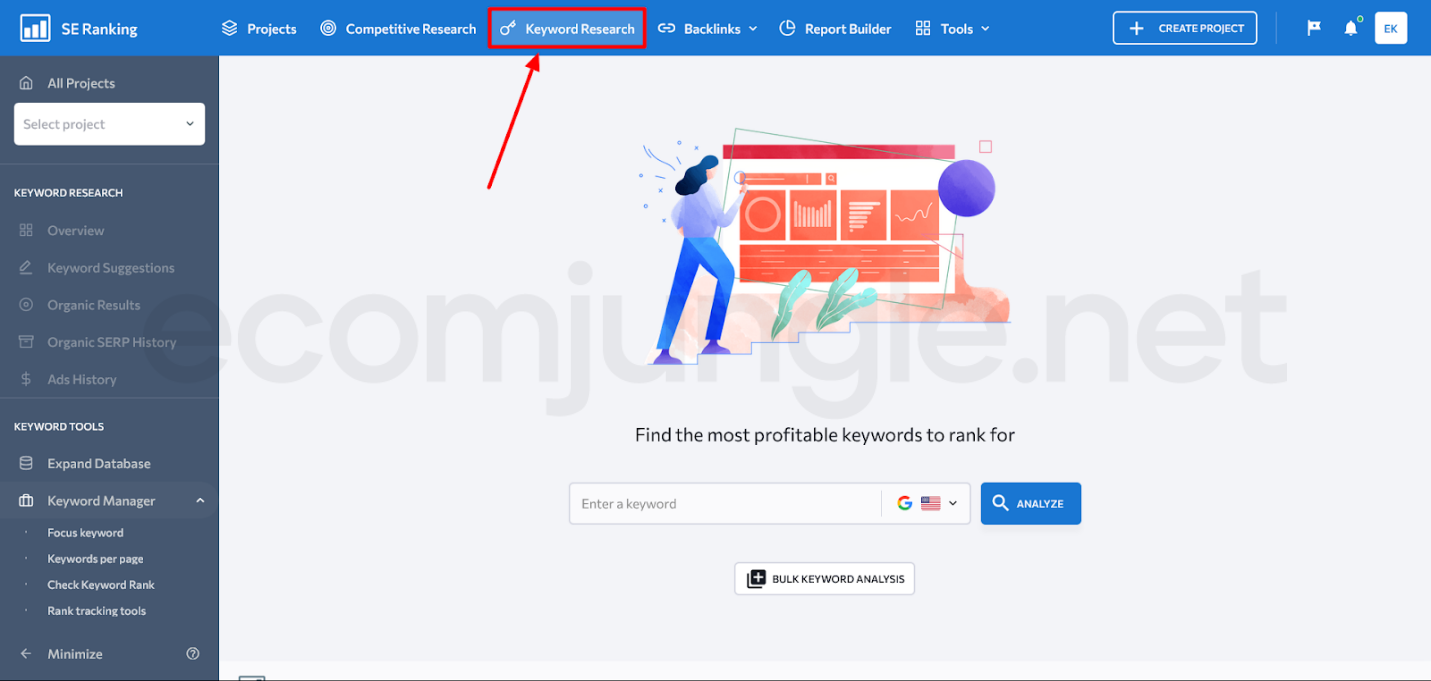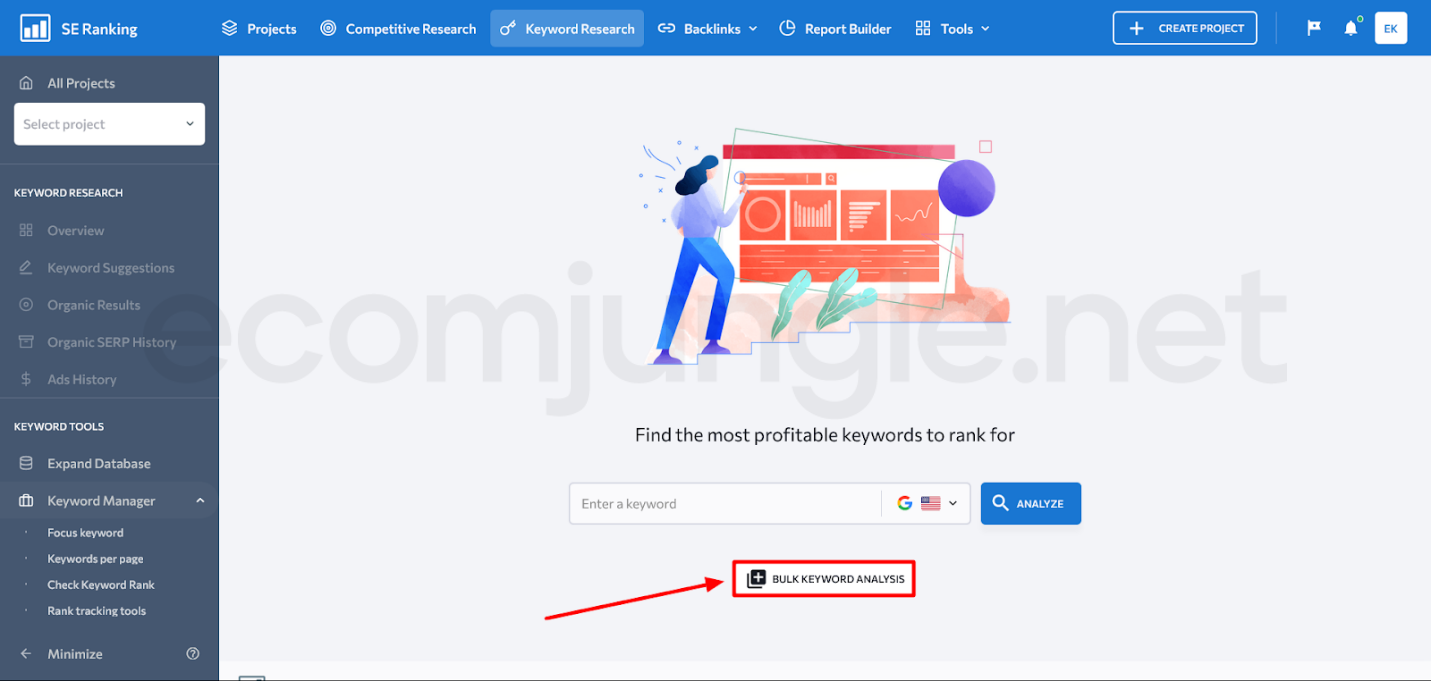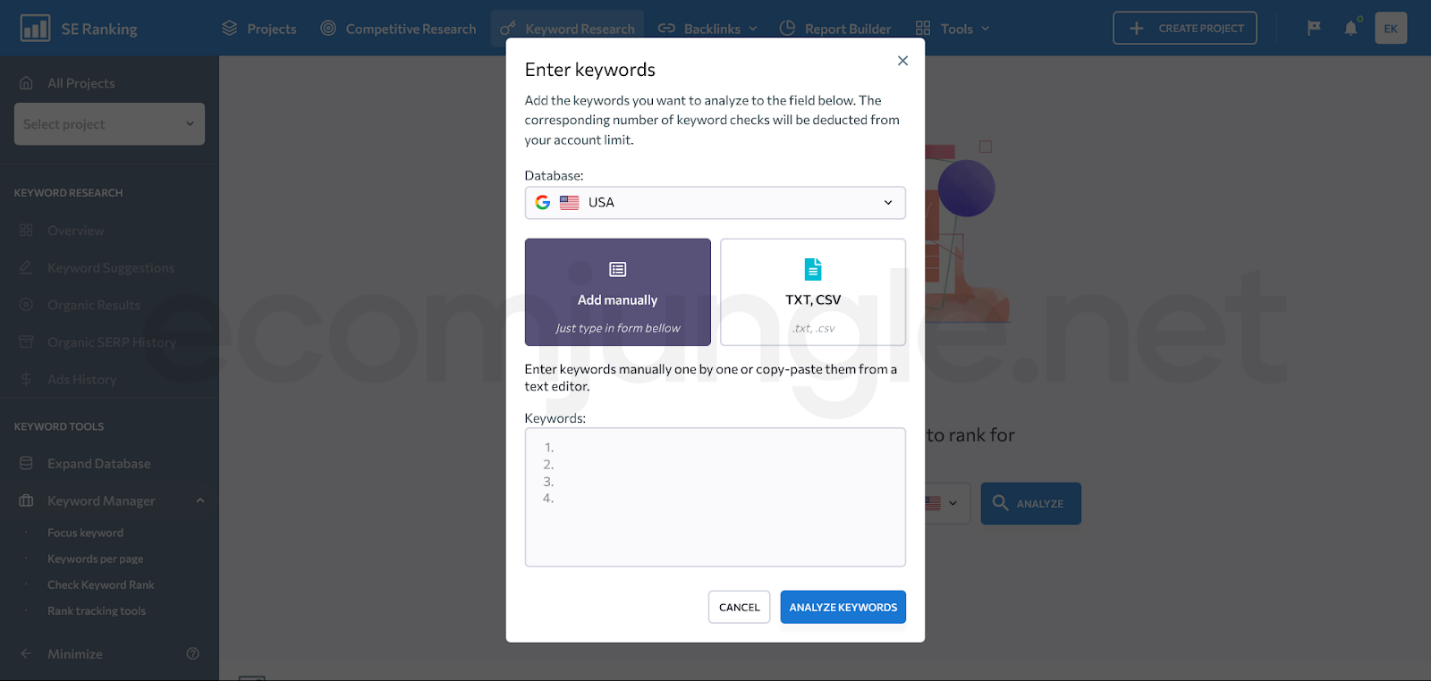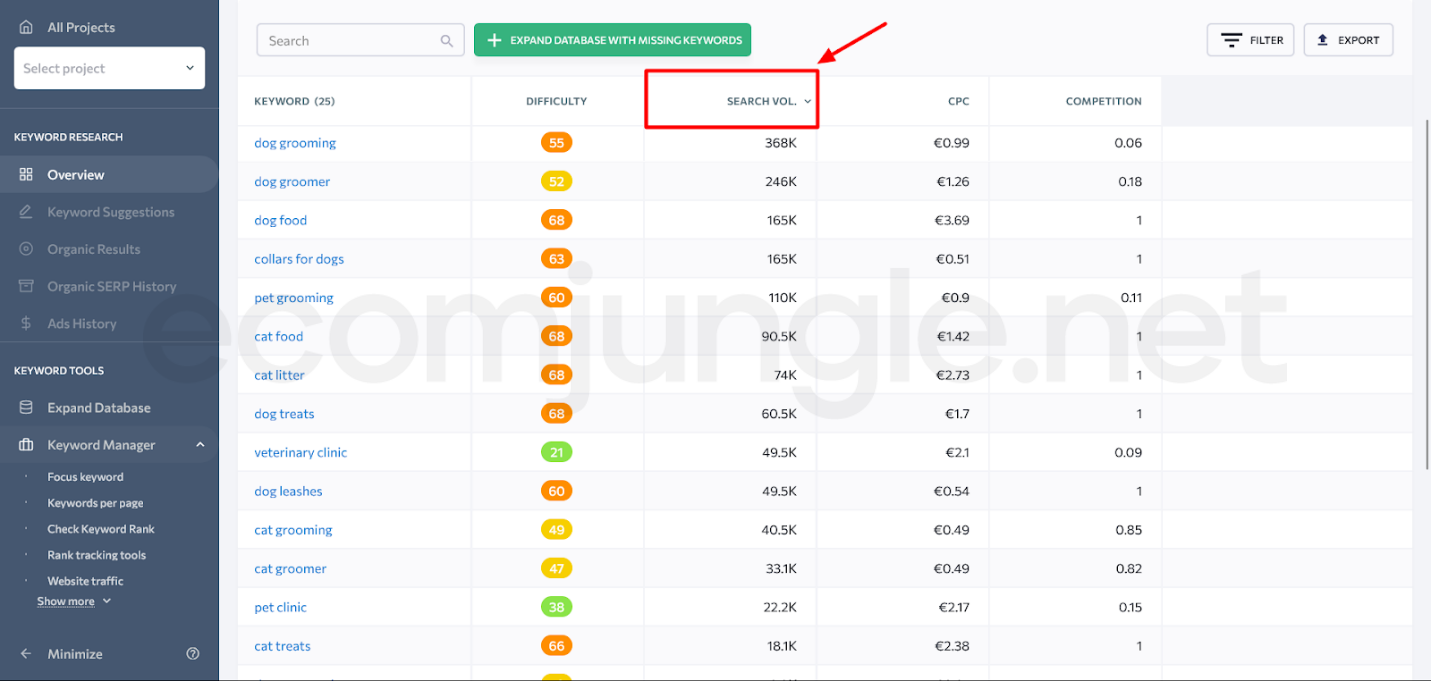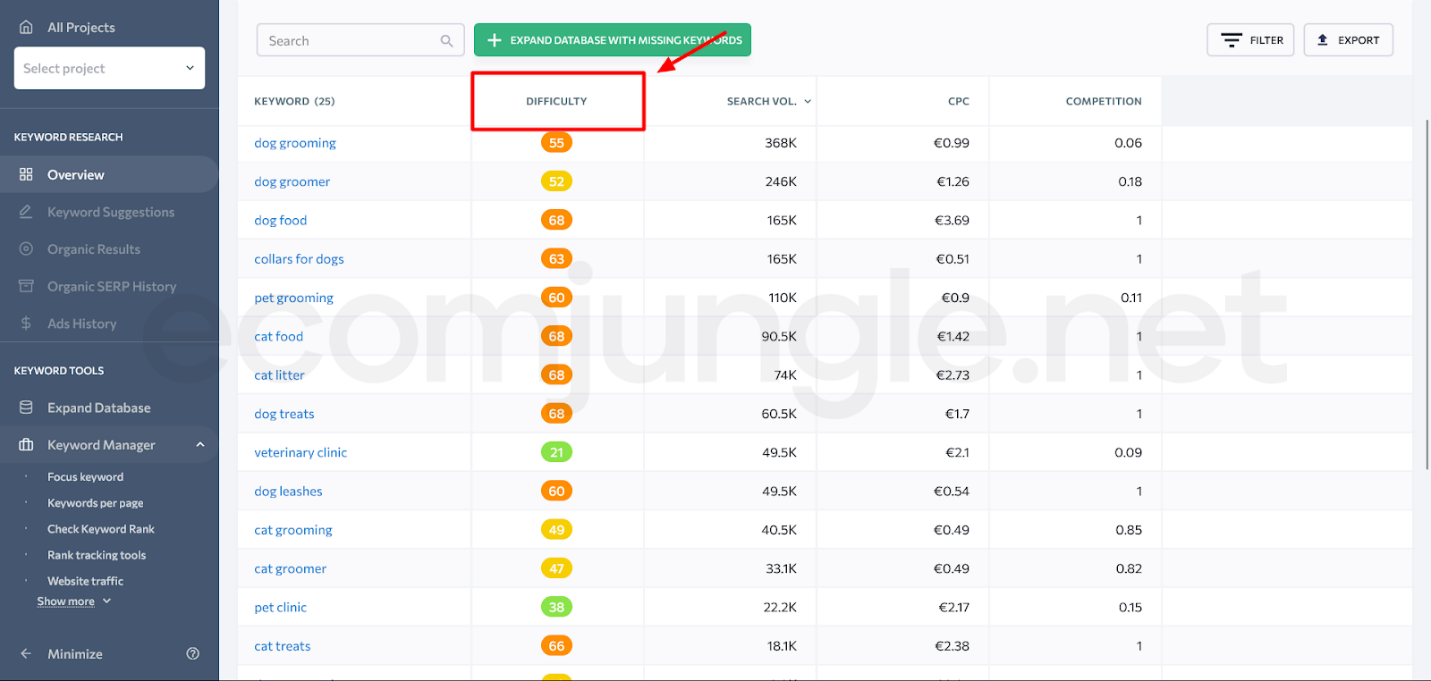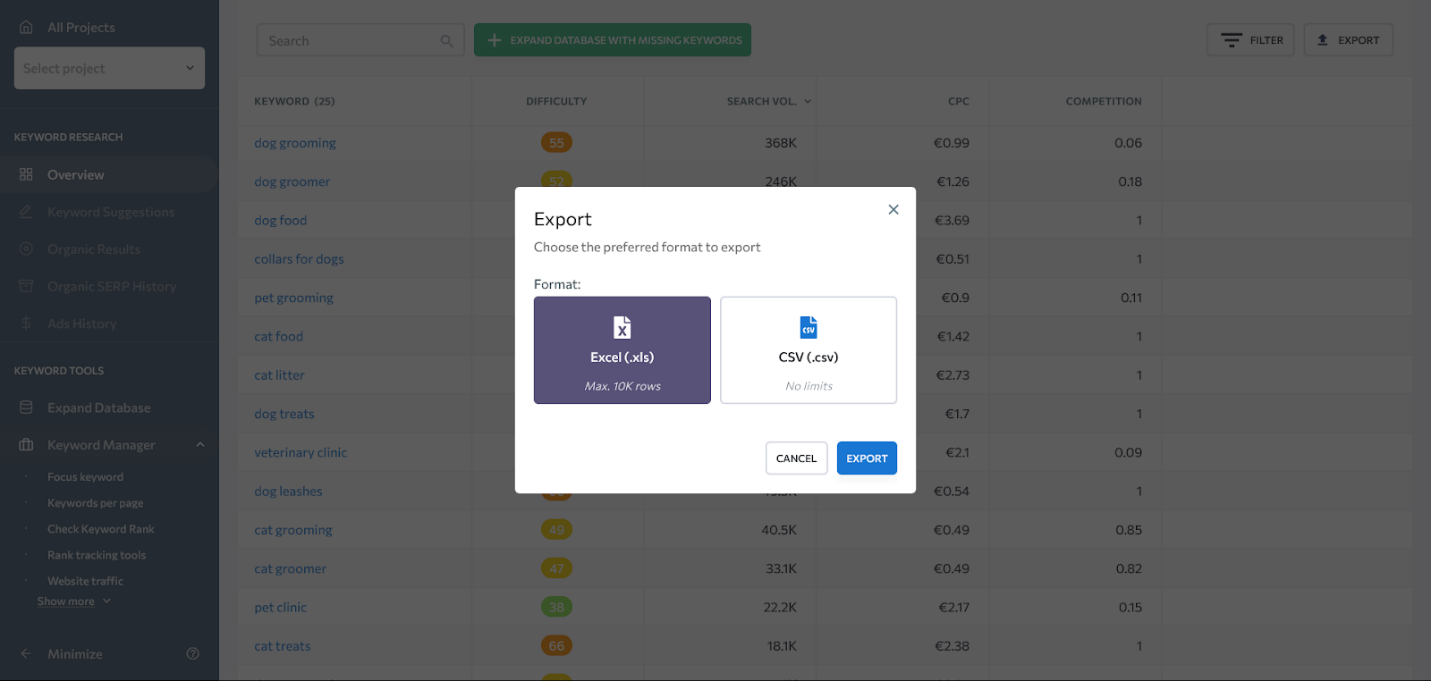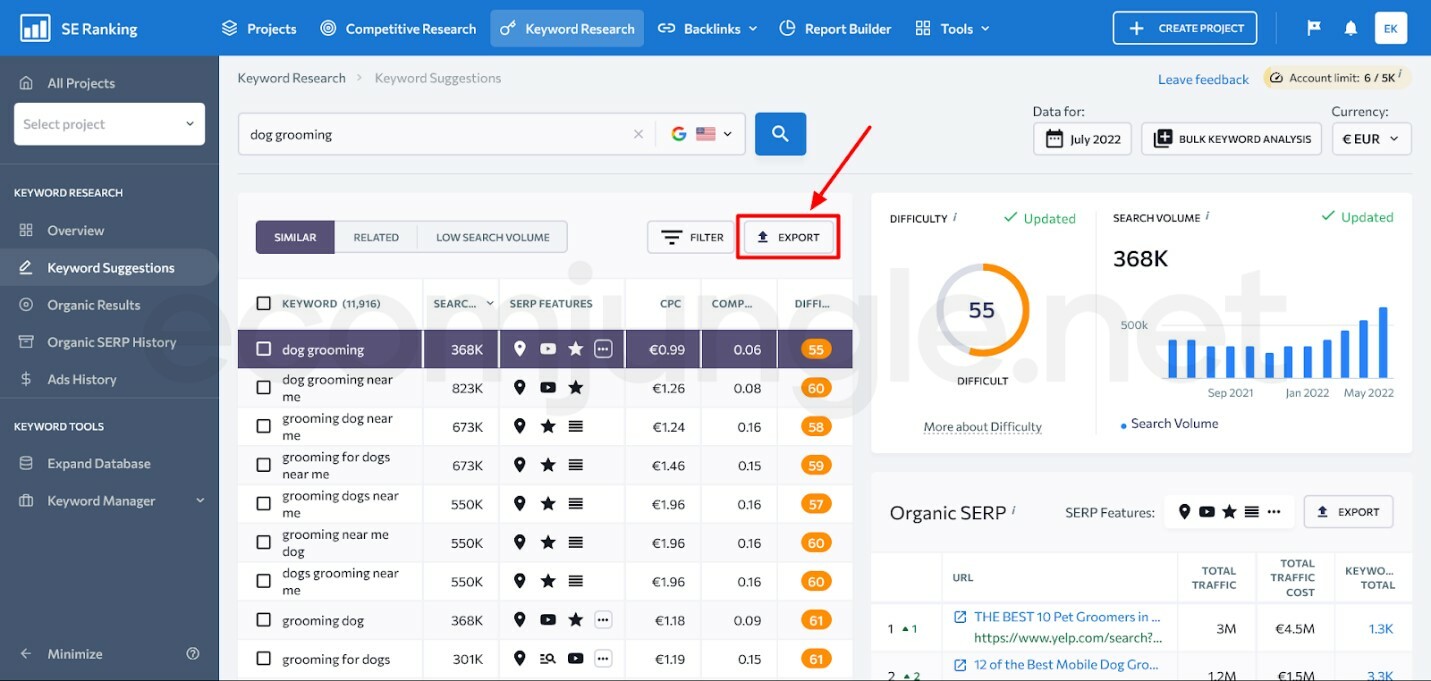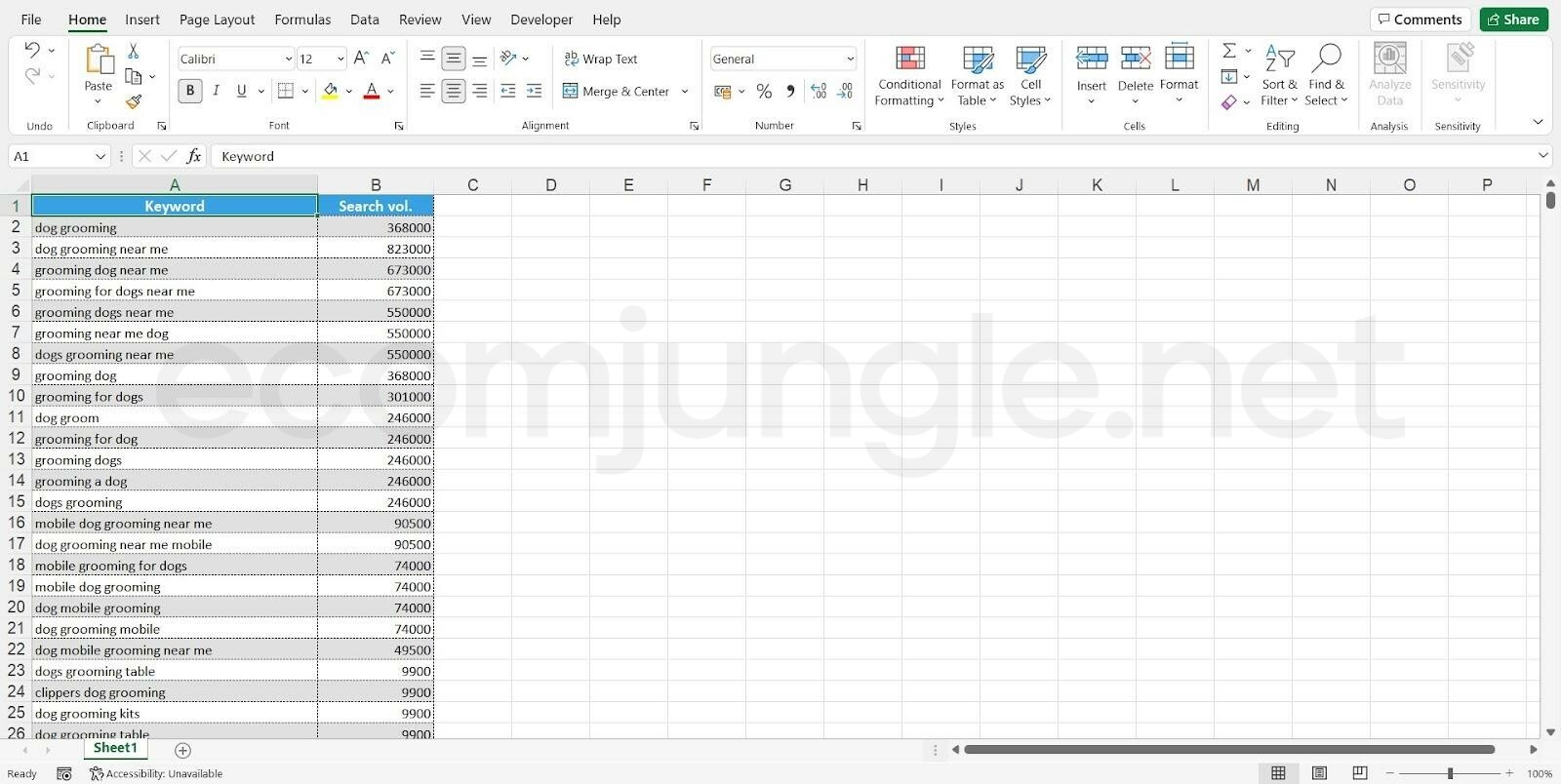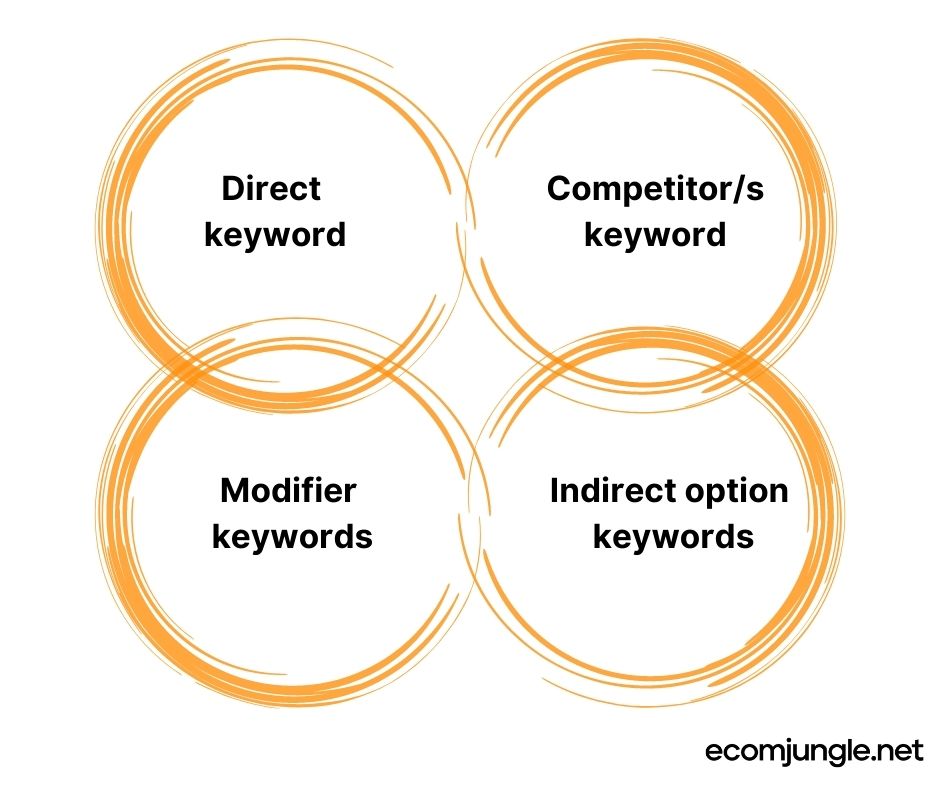So, what do you do when you want to buy a product online? Bingo! Your search for it on the Internet, your customers too, and they often select the first search engine results pages.
For your products to be successful, you must choose keywords relevant to search engine algorithms to attract the public, and although this may seem like child’s play, the truth is that many entrepreneurs fail miserably. So today, I present a beginner’s guide on how to do keyword research for eCommerce, and don’t die trying!
- What Is Keyword Research Focused on eCommerce?
- Why Should I Do eCommerce Keyword Research?
- eCommerce Keyword Research: Class 101
- What are keywords?
- Seed keywords
- Monthly search volume
- Short-tail, Medium-tail and Long-tail Keywords
- Search intent: it’s about what they want to find
- Search engine results page (SERP) intent – Are those keywords relevant to the page and content type?
- Keyword difficulty – The importance of being realistic
- How To Do eCommerce Keyword Research: Step-By-Step
- Step 1: Define your keyword research goal
- Step 2: Brainstorm keyword ideas
- Step 3: Find seed keywords
- Step 4: Generate keyword lists using keyword research tools
- Step 5: Organize keywords in related groups according to the theme
- Step 6: Do competitor research
- Step 7: Select niche keywords to win
- Step 8: Apply keywords in Your eCommerce website
- Use Keyword Rank Tracking Tools To Track Your Results
- To sum it up
- Frequently Asked Questions
What Is Keyword Research Focused on eCommerce?
HubSpot found that 60% of marketers trust inbound (SEO, blog content, etc.) as their highest quality source of leads.
In simple terms, keyword research for an eCommerce site is to find all the keywords your audience uses to find products similar to those you offer.
Then, it is how they present those doubts or queries to the search engine so that you add those search terms to your SEO strategy, and finally, your customers can find you faster.
So, what can I do with those keywords?
Well, you can:
- Find seed keywords around which your SEO efforts will revolve.
- Make a list prioritizing their relevance to your site.
- Use them to map your website and get a robust site structure.
- Add them to create different categories and subcategories for your products and services.
- Write your products and services descriptions.
- Create filters and attributes in your product and service descriptions.
- Add them to the descriptions of your images, videos, and other multimedia elements.
- Add them to your meta description, title, and H-tags.
- Get ideas for your blog posts and content categories.
- You can discover the best format and angle for your content for those keywords you are implementing.
Why Should I Do eCommerce Keyword Research?
The main reason to do it is that your audience can find your website; it doesn’t matter how nice your online store looks or how innovative your products or services are if customers don’t know your business exists.
To achieve visibility, you must build and map an SEO eCommerce website architecture, create SEO-friendly content based on keyword research to meet the search engine algorithm’s metrics, and respond to the users’ needs. Then you can get to the first page.
According to Backlinko, only 0.78% of Google searchers click on results from the 2nd page.
Good keyword research for eCommerce helps you have a clean and SEO-friendly URL, snippets, slugs, and optimized meta descriptions, among other good practices that are favorable for your SEO positioning.
And the best part? If you do it first, you avoid additional costs in rebuilding your site to search engine optimization.
If you are still thinking about it, here are five main advantages it offers you. So, let’s dispel those doubts more!
1. You will learn how to arouse the interest of your lead target
An eCommerce keyword research helps you discover how your audience interacts in the search bar and what terms or phrases generate the most queries for your type of product online.
Then, by using them in your content, you can increase the organic traffic to your site and get the golden ticket for every new business: to increase the conversion rate.
2. You will know what is relevant to your niche and your competition
You probably wonder why I want to do competitor research, “my products are unique,” or “I want to create something never seen before.”
That’s all well and good, but to get to the heart of your customers, you need to answer questions such as:
- What are search results?
- What is a focus keyword?
- Which marketing techniques are working for them?
Use Google search or Amazon suggestions to find related keywords to your products that are positioning them on the eCommerce platform and use them to your advantage. You can’t win the battle without the right weapons!
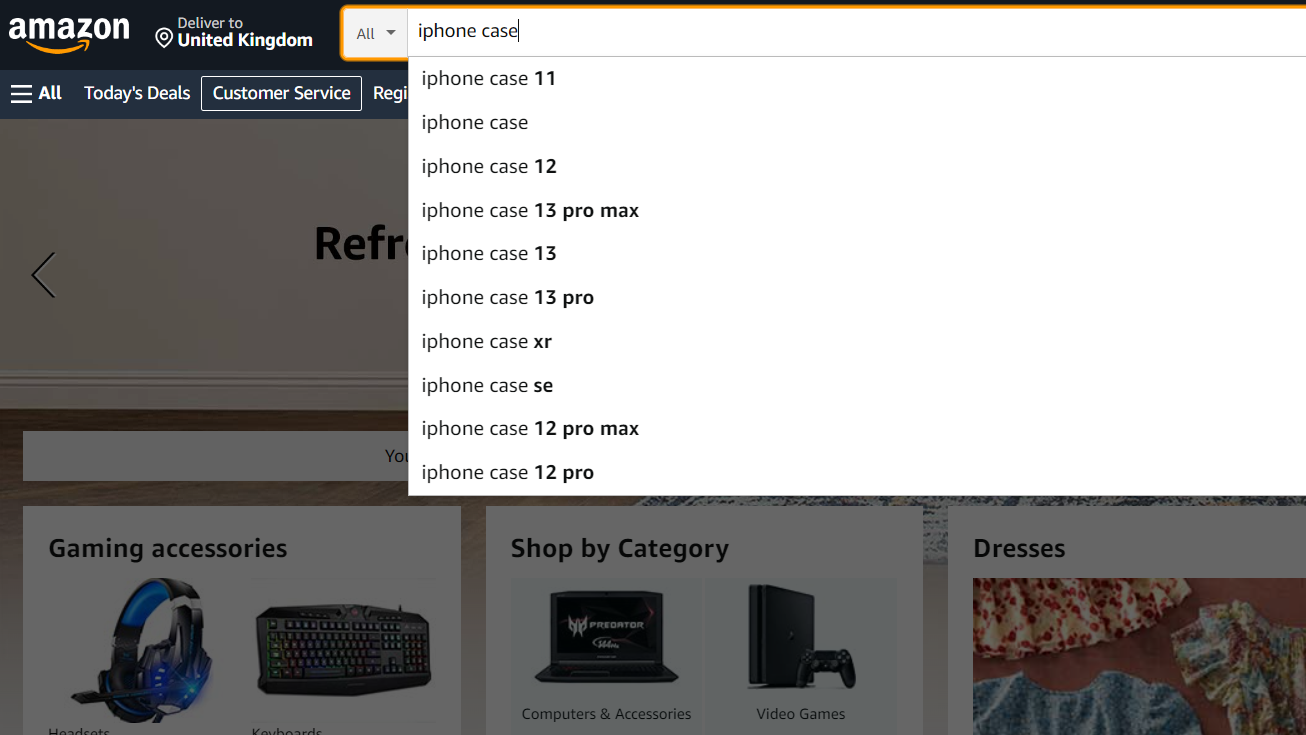
3. You will design a clean and easy-to-navigate site to improve the user’s experience
I know firsthand that the sites you create with the help of eCommerce platforms are not exactly the neatest; the first step to leaping is to create a solid foundation that serves as a springboard.
How to do it?
The million-dollar answer is to do keyword research for an eCommerce website and learn how many keywords to use per page when optimizing and what titles, tags, and category pages you need to include to provide a better user experience. The idea is that users know where to click to find what they need.
4. You will create content with a long-term impact on search engines
Designing a keyword marketing strategy for your eCommerce business involves significant time and effort, not only money.

So, you need to focus on creating SEO-friendly content that doesn’t quickly become outdated; keyword analysis reveals trends and search projections so you can boost your online positioning.
5. You will know how to build an SEO-Ready architecture for your eCommerce Website
Keyword research helps you to know where and how to apply keywords for SEO in your eCommerce website; this allows you to have an optimal semantic web structure that follows a logical order with the necessary depth levels according to the size of your website and the type of content.
The idea is that from the home page, the items in the navigation menu, the categories, and subcategories, as well as the rest of your taxonomy (meta description, title, tags, filters, descriptions, etc.), follow a hierarchical relationship from what we consider more relevant or general to those more specific.
All this helps the algorithm of Google, Bing, Yahoo, or any other search engine to understand your web content so that its crawling and indexing is easier.
And best of all, you offer the user a good browsing experience that is responsive to their search intent.
eCommerce Keyword Research: Class 101
Let’s start this support guide by defining some elementary terms when we want to enter the world of eCommerce and increase our online sales. Beyond the quality, presentation, and price of our product, you need to master these keywords of your niche so that the public can find you in the search results.
So let’s go for it!
What are keywords?
Keywords are those phrases or terms (metadata) that users type in the search engines of their choice and that link them directly to a page or website that the algorithm considers most relevant to their needs.

Seed keywords
These generic keywords have a high volume of searches and a lot of competition. They are the initial concepts that come to your mind, products, categories, and needs.
Seed keywords are composed of 1 or 2 terms and are an excellent inspirational starting point for your keyword research. From your selection, you can find other variations closer to the “core ” of your business and help you get quality traffic and the goals you set.

If your company is a professional bicycle shop, the keyword seeds or keyword heads can be mountain bike, bike, bike trails, etc.
Monthly search volume
When I refer to search volume, I’m talking about the number of times users enter a term into the search console per day, week, month, or year. The highest search volume means more queries per term.
When you do your keyword research, you are interested in selecting words that users use to get potential sales; otherwise, you are wasting your time.
Specialized tools like SE Ranking, Google Keyword Planner, Moz, etc., can help you to know the volume, position variation, and traffic of a term or phrase.
Pro Tip:
You should know that the percentage these tools give you is an approximation. Each tool offers a different rate so that you can trust them 100% in their results; you must see them as tendencies to prioritize your keywords.
Short-tail, Medium-tail and Long-tail Keywords
You need to consider that not all keywords are the same; they differentiate by length (a single term or composed phrase), traffic, difficulty, and ability to catch your customers better. But don’t panic; it’s not rocket science!
1. Short-tail keywords
These keywords are composed of 1 to 2 terms, which can open up a much more comprehensive search field. The advantage is that they generate high traffic, but their competition level is high.
Example: “women’s clothing“.
If you want to learn more about Short-Tail Keywords check this article.
2. Medium-Tail Keywords
These are more specific than short-tail keywords, usually composed of 3 or 4 words on average. They filter users’ search toward the content they want with more specific results.
Some experts say they are the best option among the three types, next to the long tail and short tail, as they offer the best of both worlds, have a frequent search volume, and are not as high and competitive as short tails.
Example: “perfumes on sale” or “chanel perfumes on sale“.
3. Long-tail keywords
These are search phrases composed of four words or more; they offer a more detailed and refined approach to search queries. Moreover, they have as a point in their favor that they have less competition and a higher conversation rate and therefore tip the balance in your favor to direct and motivate your customers to click to buy.
Example: “best healthy treats for dogs“.
A great option to discover long-tail keywords is using a specialized keyword tool.
Search intent: it’s about what they want to find
How to get quality traffic and target the right audience? To do this, you must consider the keyword intent or the purpose for which the user makes the query to give them the correct answer.
You must put yourself in your customers’ shoes and think about what they want to solve and find before choosing a particular keyword.
Users click to search for 5 purposes:
- Informational – they want to know the answers to a question, “what,” “how,” and “when”.
- Investigational – to deepen their knowledge about a topic.
- Navigational – when they want to go to a page or article.
- Commercial – they consult brands, types of products, “women’s clothes,” “gucci bags”.
- Transactional – want to buy a product and search for “promotions” or “sales”.
Search engine results page (SERP) intent – Are those keywords relevant to the page and content type?
SERP intent is what Google and search engine metrics evaluate as interesting, attractive, and novel in your niche and shows it as the best option for users in the SERP. Knowing it allows you to discover the north to follow, that is to say, which content formulas are in trend for your type of products, and to approach better to your audience, either with tutorials, product comparisons, etc.
Pro Tip:
To test keyword intent and SERP intent, go to google incognito mode, type in keyword, and look what’s the outcome.
Keyword difficulty – The importance of being realistic
Difficulty tells how likely are the keyword chances to rank in the top positions on Google’s search to get more visibility. The higher the number, the more challenging for you to stand out because too many sites compete with the same term.
It is a critical metric in your selection process since, usually, short-tail keywords have a high search volume. However, the ranking difficulty increase since your competitors is also looking to rank for them. On the other hand, long-tail keywords, although they have a lower monthly search volume, have a much lower difficulty index, which indicates that the way to rank for them will be much easier.
You need to keep your feet on the ground! It’s not enough to find “easy to rank for” keywords; you need to find the perfect balance between high search volume, SERP intent, and keyword difficulty to hit the mark. Yes, you guessed it, it’s a time-consuming process, but it is all worth it, I promise!
If doing your research, you find many sites are struggling to rank for a keyword you were going to include, don’t be discouraged because the algorithm also examines other metrics to propel you to the top:
- Relevant to the user: Does your content answer the search intent?
- Authority: Does your content show expertise, reliability, and quality?
- Link Building: Is your content relevant for other sites?
It’s not a Google metric; it is a metric or index that keyword research tools have a different algorithm to calculate it
How To Do eCommerce Keyword Research: Step-By-Step
This guide would be incomplete if we focused only on sharing definitions and concepts, so to give you that shot of confidence, you need to take the first steps in the SEO world. I will guide you on how I do keyword research when I need to create a new eCommerce website structure, grow organic traffic to an existing site, or launch a new content marketing strategy.
These are what has given me the best results:
- Define your keyword research goal.
- Brainstorm keyword ideas.
- Find seed keywords.
- Generate keyword lists using keyword research tools.
- Group keywords according to the topics.
- Do competitive research.
- Select niche keywords to win.
- Apply keywords in Your eCommerce Website and content strategy
Step 1: Define your keyword research goal
It is vital that before you start, you have defined what you aspire to achieve with it; this helps you to evaluate the best options for your eCommerce.
Setting a goal for your keyword strategy helps to align all actions to achieve it.
For example, suppose you are looking to increase the number of sales of your products or services. In that case, ideally, you should target your search for words that motivate purchases, and your possible options should include terms such as reviews, demos, advantages, and sales, offers.
Step 2: Brainstorm keyword ideas
For this second step, you should think like a person without a lot of knowledge about your industry would. The goal is to put yourself in their shoes to establish the keywords they can use to find your eCommerce website.
To keep in mind:
- What are base keywords? It is the step to identify the terms best describe your business, products, and services.
- The list should be 5 to 50 base keywords long; you can use more if needed and feel that you have covered the essentials.
- If you are using professional terms, you should include more simple terms, which people use daily, so there is a broader spectrum of choices from which people can find you. In this case, you need to look at this from several angles.
To start this process, I suggest the following:
1. Create a blank spreadsheet or Google document to write down all the ideas that come to your mind.
2. Think about your products and services and name them one by one. What is the first word that crosses your mind thinking about them? Those terms can help you because your audience thinks of them too. Trust your common sense!
A practical exercise to put your mind to work, answer these questions:
- What is my website about?
- What is my eCommerce about?
- What products and services do I sell or offer?
- In which category can I include my products and services?
- What is my business’s niche?
- What need are they fulfilling with my business, services, or products?
- Who is my ideal customer?
- What topics are closely related to my business?
- How can people find my website?
- What keyword would I want to rank for in the search engine?
- With which keyword could users or potential customers find me?
3. Write down all your keyword ideas, even if you repeat some of them or are very similar because this indicates their priority or hierarchy in your search.
These keywords will be the base for your seed keywords, but that’s the next step.
Step 3: Find seed keywords
The third step, you need to strengthen this list of keywords you have from step two to obtain seed keywords. These terms have the added value of serving as a root from which content ideas emerge and help you refine your list of relevant keywords (short, medium, or long-tail).
If you’re looking for inspiration, here are three options to get you started:
1. Terms that users use in their search queries
When entering a niche, you know how important it is to understand the customer’s needs. By searching for keywords, you can look at reviews of similar products or services, their opinions in product descriptions, chats, or forums, and even the complaints they make to support. You may find several ideas repeatedly in their views on including them in your list.
Note:
Not all keywords will be your niche keywords, and not all of them will be relevant to you just because maybe you will not be providing these kinds of services or products; these you should delete immediately so they don’t mess with your head.
2. See the options that Google Search autocomplete, and the user also asked suggests

Google can be a great ally as you can enter the terms in your list and see what the engine suggests to learn other keywords that may interest your target audience. When you have entered several words, you will notice which ideas are repeated and essential to your topic or industry.
3. Use a keyword research tool

These are computerized tools that you can enter a term, and they will offer you the most relevant data, such as its position in the different search engines, by country, region, or locality. There are excellent options on the market, including free tests such as SE Ranking Keyword Research Tool, which tells you the search volume of a word, its ranking difficulty, and how it ranks. Learn more about the best keyword research tools.
4. Meta title in Google
It is possibly the easiest way to find out what keywords users use in their queries.
5. Spy on your Competitors’ Keywords
An incredible way to speed up your keyword selection process is to keep an eye on your competitors and know what keywords they are ranking for and which ones they are leaving out, but it may be an opportunity for you.
Check out some of the advantages of Se Ranking!
An easy-to-navigate interface is ideal for identifying your competitors as you enter your keyword idea, select your country, and click search. That’s it! In seconds Se Ranking shows you a list of suggestions sorted by search volume and ranking index, of the sites ranking for that keyword, and the organic traffic it generates for them.
How to use SE Ranking for keyword research? That’s what we’ll look at next!
Step 4: Generate keyword lists using keyword research tools
Most of the available keyword tools offer you a detailed list of the most relevant queries, considering the questions the public asks. In addition, they exclude options based on their prepositions and even provide suggestions by city, region, or country if you bet on a local SEO strategy.
- Go to SE Ranking and start a free trial.

2. Set up an account.
3. Press the keyword research button on the top of the page.
4. Enter your keywords by choosing the bulk keyword analysis.
5. From there, you can either choose to enter keywords manually one by one or copy-paste them from a text editor.
6. When you have entered your keywords, press “Analyze keywords,” and then you should pay attention to 2 parameters:
Search volume – The total number of monthly searches for a particular search query, excluding topically related keywords.
The search volume is updated every few months and calculated based on information from Google, SE Ranking algorithms, and clickstream data. Keep in mind that even though there is a downward trend in search volume when you are scrolling down the list, even the keywords with a low search volume are still crucial to your website because they still are a way for people to find your website.
Important to remember
Each SEO tool will show you a different search volume because it is not entirely accurate, somewhat approximate results over a specific period. For example, SE Ranking doesn’t update search volume data for every country database simultaneously. Typically, once they finish updating a database, they move on to the next. As a result, they manage to fully update the search volume for each country’s database 2 to 3 times a year. The thing you should pay attention to when looking at search volume is the tendency, whether the trends are going upward or downward, and hierarchy.
Difficulty – Keyword Difficulty indicates how challenging will be for your website to rank among the top first page results for this keyword: the higher the score, the more effort will take.
To calculate the difficulty score, the tool analyzes the quality of the top 10 organic search results and their link profiles. As it changes over time, it is recommended to update the score manually. Though the most popular keywords have a high difficulty, you should still include them in your keyword lists because they are your website’s backbone.
You could also possibly see a notification “We couldn’t find data for keywords in our database”. That means some of the keywords you entered are not in their database.
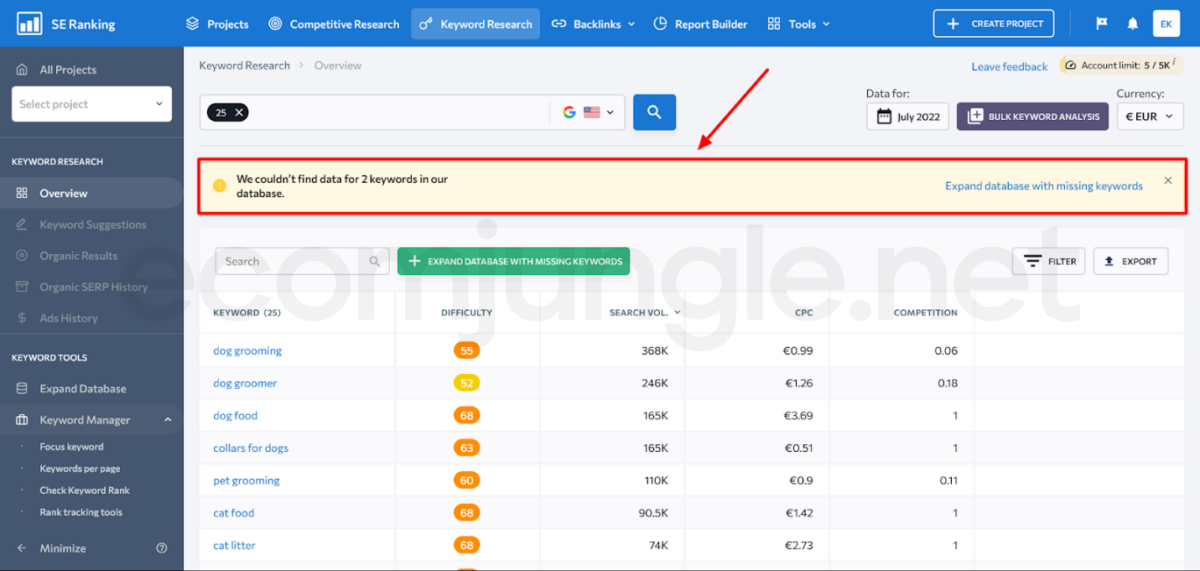
7. Next step is to export your keywords; this is so that we can, later on, analyze and group these keywords.
To do that, press “Export” and choose your preferred format. In this case, I would select Excel(.xls)
8. Now that this is done, go into “Downloads” on your computer and open up the file that we just exported; it should look like this:
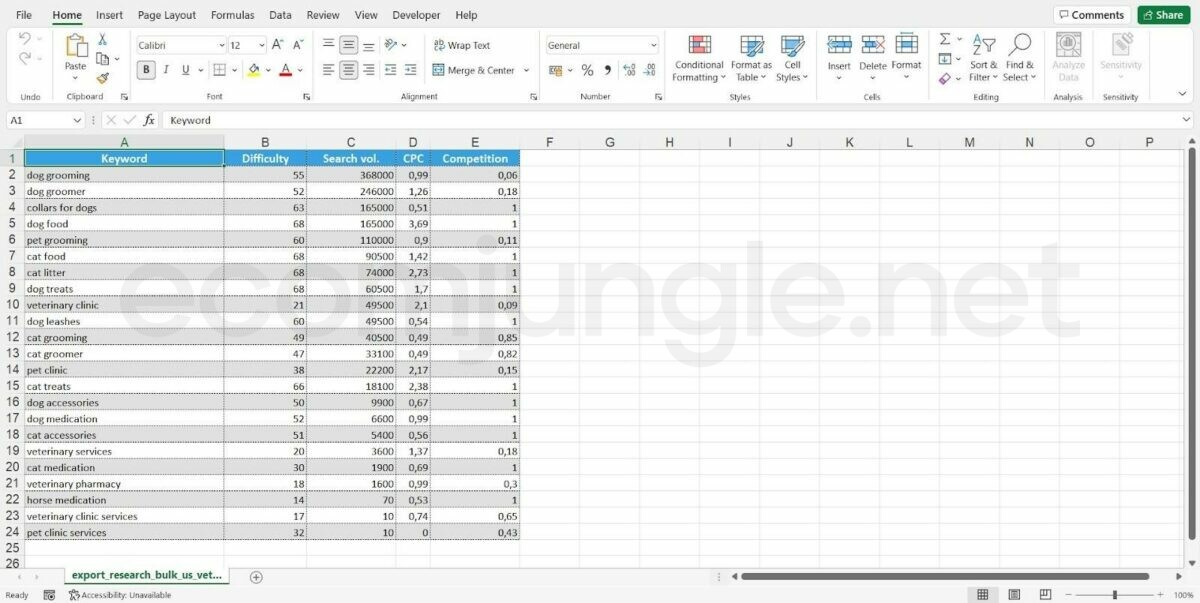
9. The only two things that you will need from this are the Keyword and Search vol. Column; the rest you can delete. Then you should be left with something that looks like this:
That’s how you generate a keyword list.
But that is not it!
10. Go back into SE Ranking, and now you should click on each of the keywords one by one to open up the keyword suggestions option.
11. From there, a page will open up that looks like this.
And what you should do is again – export it and open up the file.
12. When you have opened up the exported file, again clean it up by deleting the info that you don’t need- everything except the keyword and search vol. Column.
13. Now repeat these last two steps for all the keywords in your list.
After this, you will have a lot of keywords that are relevant to your potential customers and searched by them on Google.
Next up – Organize keywords into closely related groups, where you will use your previously generated lists and organize them in groups.
Step 5: Organize keywords in related groups according to the theme
You must remember that when selecting your related keywords, you are sending a message to your audience, so it is imperative to be consistent. Yes, it may seem obvious, but I have seen many cases where entrepreneurs are not clear about their vision and try to address it so much that they drift away.
Select and classify your terms based on your target topic or product in your keyword research process. A target keyword for your product pages to scale progressively since the site’s algorithm processes and makes your page visible, considering the titles, subtitles, and tags you have.
Try to create your groups by including more generic and specific keywords that will give you the best of both worlds, higher search volume and a better chance of ranking first with that term.
We will be looking for interrelated keywords and keywords with a similar meaning to form groups from them because keyword research is not just about finding the right keywords. It is also about a broader study and the search for context.
Ways to divide keywords into groups:
- The first thematic group that you could divide your keywords would be a group of direct keywords, in which the keywords point out the services/products/product groups/ brands represented by your company.
- Competitor keyword group – these are the keywords that refer to a competitor’s brand or the brands represented by competitors’ products.
- Group of indirect option keywords – in this group of keywords, your offered products, services, or brands are not directly named; these are important because they can still catch the attention of a potential customer and bring them to your company. These answer user questions/symptoms/user problems/possibilities/jargons/personal names/terminology.
- Group of modifier keywords – consists of base keywords followed by location or seasonality-related words.
Process of grouping:
- Open a new Microsoft Excel document or google spreadsheet; this you will use as your space for all your keyword groups.

2. You should open your previously made keyword suggestion spreadsheets and divide your keywords into groups. Firstly, you need to find similar keywords and use these combinations, “Ctrl + X” and “Ctrl + V,” to pull the keywords you have chosen to put in one group to the side. It should look something like this:
3. Next step is to Copy this bundle of keywords and paste them into your blank spreadsheet.
4. Now that you have done that, you can return to the spreadsheet of suggested keywords and delete the empty rows so your document is more transparent.
5. Repeat these steps for all your desired keywords in this sheet and then move on to the following suggested keyword sheet. In the end, it should look something like this:
You, of course, will have many more groups and keywords; this is just a tiny example.
Note:
If you notice that some of the keywords have a search volume of 0, remember that that is an approximate number between 10 and 0, so you should consider it as a 5 and still think of these keywords because they could still bring at least 2 to 3 potential customers a month to your website. If this number is a 0, SE Ranking would not suggest these keywords to you.
Step 6: Do competitor research
This research helps you know where your competitors rank and what keywords drive traffic, your chances of getting to the top page, and discover uncovered topics. Why? You can find out how long and much work it will take you to get to the first page.
You also get ideas and angles to create better strategies to climb to the top because, in the case of eCommerce sites, if you are not in the first position, your chances of conversion are meager and revenue minuscule.
As Sun Tzu said in the Art of War, know your enemy! Examining your competitor keywords gives you a clear vision of the strategies providing positive results. So you see if you are targeting the right place, or on the contrary, discover that you should redirect and reformulate your action plan.
When doing your competitive research, you should remember that different types of competitors exist. So you should not only look for businesses that sell your same products or alternatives to them but also those that have the possibility of limiting your market share, hindering your positioning.
Here are a few tips to keep in mind when identifying your competitors:
- Detect their target keywords.
- Consider how much authority the site has to rank where it is.
- Observe if other websites in the niche link to your competitor to know the domain authority.
- Find out their backlinks, which sites are linking, and helping to generate more traffic.
The process of competitive research for eCommerce SEO allows you to rank for keywords your competitor hasn’t detected and discover opportunities that could generate more organic visits soon. This is in line with GrowthBar found that about 20% of keywords searched on Google on any given day have never been explored. You can see which fronts they are not covering and make your way.
Step 7: Select niche keywords to win – Identifying keywords with a good balance of search volume and competitiveness
In this phase of choosing keywords, to build the foundation of a robust SEO-Ready eCommerce website and winning marketing strategy, you need to focus on locating terms in your niche with high search volume and low-ranking difficulty.
According to Databox, 70% of online marketers say that SEO is better than PPC for generating sales.
Remember that your goal is for your audience to be able to find your products and increase the traffic your site receives. Therefore, you need to know what they want and offer it to them.
I suggest you bet on long-tail keywords that are more likely to bring you a better target genuinely motivated to buy, which directly affects your conversions.
I understand that it’s tempting to focus on shot-tail keywords with high search volume, but that’s a typical mistake many entrepreneurs and marketers make when doing keyword research.
Making a list of prioritized keywords
As mentioned above, you should cover fundamental selection criteria when executing a keyword selection process for your eCommerce store that can be the starting point for higher and better online sales.
The four prioritizing keywords criteria are:
- Search volume (the number of monthly queries for the term).
- Search intent and relevancy (why customers make their queries).
- Search engine results page (SERP) (how important it is to the search engines).
- Keyword difficulty (how easy it will be for you to rank for that order).
Use keywords that fit like a missing piece in your website
You must try to make your keywords fit together like the missing piece of the puzzle! So, to get organic traffic, you should go from the more general words and, throughout the writing, incorporate into the content pages those more specific ones that make them look like a harmonious whole that subtly and intuitively guides your visitors to you. Discover more about how many SEO keywords per page you should focus on.
Use keywords that also match user intent
This has become a blind spot for many entrepreneurs and digital marketing experts since this task does not involve making a list of words related to their products.
To not waste time and money, you must focus on selecting the right keywords. But also on creating content that genuinely responds to the user’s original question that motivates him to click and that when he leaves your site, he has found the answer. How to achieve this? These questions can simplify this task:
- What interests my audience?
- What solutions does my business offer?
- Does my content answer the questions for this word?
Answering these questions strengthens the process of creating optimized content that has value to the reader because it satisfies their search intent and that you present in the format they are interested in:
- Easy tips.
- DIY tutorials.
- Product roundups.
- Product lists.
- Reviews.
- Videos.
- Product descriptions.
- Infographics.
- Social media post.
Use Relevant keywords
The more specific, the better! That is to say that the target keywords you select are particular to each of the pages of your site, “women’s summer tops plus size.” It allows you to give the engine just what it wants, enabling it to better crawl your page, gain more visibility, and therefore more organic traffic.
Short and Long-Term Results: High and Low-Hanging Fruits
When you select your keywords to create the structure of a new website, optimize the existing one, or create a unique content marketing campaign, you must set goals for each of the terms you have chosen. There will be one that offers you quicker results, or small wins, which are a good starting point to get into a rhythm, for example, to generate traffic to your website like short or medium tail words that can go into your titles. Then you can invest your efforts in battles that take longer, such as long tail keywords, which help you get closer to increasing your conversion rate.
Step 8: Apply keywords in Your eCommerce website and content strategy calendar
Once you have completed your research, you not only have a set of keywords that you have prioritized according to their search volume and difficulty index. But you know how many keywords to focus on, where and how to apply keywords for SEO in Your eCommerce website. Even the format and angle of the content you create for your website should have.
What’s next? Get to work!
What was your initial goal for the keyword research process?
- Apply to that goal
- Apply to the website
- Plan content strategy
- Plan marketing strategy
- Create a publication schedule
- Set the publication dates (every week, twice a week).
- Organize the development of each topic according to the keyword priority and ensure that the content type responds directly to the users’ search intent.
Use Keyword Rank Tracking Tools To Track Your Results
You are wrong if you think your job finishes when you group and find related keywords by niche and incorporate them into your eCommerce website structure or SEO content marketing campaigns! No, you need to track your main keyword rankings continuously to measure your results and fine-tune your strategies. You must monitor the progress and see what is working and what is not in relation to your keywords to make the necessary adjustments.
One tool I use for rank tracking my clients’ websites is the SE Rankers Rank tracking feature, which offers significant advantages to measure your domain and that of your competitors closely.
If you want to know more, I invite you to check my opinion about the best rank tracking tools. I will tell you about their features, advantages, and disadvantages.
To sum it up
Remember that keyword research is the art and science of identifying, prioritizing, and choosing the best words for structuring your eCommerce website and content to match users’ search intent and search engine metrics, so it should be a constant game. Optimizing your online store based on the strategic keywords you have identified will take time to see the first results. It is a long-term game as Google also considers a website’s reputation and history when ranking it.
To know if your actions are working, measure the results of your short-tail or long-tail keywords.
Do you have experience doing keyword research for an eCommerce site? Do you want to learn more about choosing the best keywords for your website?
Tell me everything in the comments; I want to hear from you!
Frequently Asked Questions
First, it allows you to explain to the search engine what your store is all about. Second, it will enable you to keep up with the needs of your potential customers and design eCommerce SEO strategies that naturally awaken your audience’s interest in the products you sell online. It gives you a better picture of your market and the demands you must aim to satisfy to leap.
They are beneficial because they allow them to find the products they want to buy in much less time. Keywords serve as a compass that tells them which sites or pages have what they are looking for.
Avoid messing up with your overthinking; use your favorite keyword research tool, which generates a list of different options sorted by topic, search volume, competition, and difficulty, and give suggestions of the words that might work best for you.
See what keywords are working for your competitor’s business. It gives you a clear idea of your potential customers’ query trends and how they formulate their queries so that they are the pillar supporting your SEO marketing campaigns for your online store.
A simple way to find it is to type in the search engine products similar to yours and see what the autocomplete suggestions are in the bar. Or, if you are on the Google search console, you can use valuable tools like people also asked that allow you to refine your keyword strategy before you put it into action.

